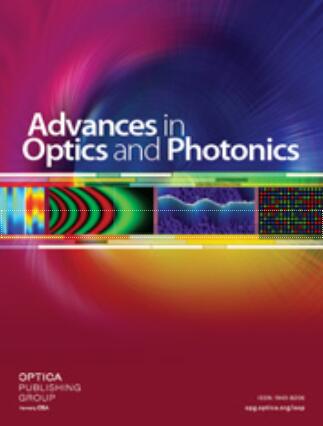参数上转换成像及其应用
IF 23.8
1区 物理与天体物理
Q1 OPTICS
引用次数: 38
摘要
本文从非线性参数上转换红外成像的起源到目前为止,对其进行了广泛的综述。上转换成像在灵敏度、速度和噪声性能方面是一种成功的红外成像创新技术。在这种方法中,通过参数三波混频,然后使用硅基检测器或相机进行检测,将IR图像上变频以形成可见/近IR图像。1968年,Midinter首次演示了使用大块铌酸锂晶体从短波IR(1.6μm)到可见光(484 nm)波长的上转换成像。这项技术很快引起了人们的兴趣,其他几个小组展示了进一步向中红外和远红外进行上转换成像,并显著提高了量子效率。尽管在20世纪70年代初发表了一些关于上转换成像的优秀综述,但近年来的快速进展值得进行更新的全面综述。该主题包括线性成像、非线性光学和激光科学,并显示出不同的应用。本文的范围是提供上转换成像理论的深入知识。讨论了参数过程的不同相位匹配条件以及上变频检测系统的灵敏度。此外,针对特定应用的上转换成像,概述了不同的设计考虑因素和优化方案。这篇文章包括该技术的历史观点、最新的技术进展、具体的未决问题以及上转换在红外成像中的一些前沿应用。本文章由计算机程序翻译,如有差异,请以英文原文为准。
Parametric upconversion imaging and its applications
This paper provides an extensive survey of nonlinear parametric upconversion infrared (IR) imaging, from its origin to date. Upconversion imaging is a successful innovative technique for IR imaging in terms of sensitivity, speed, and noise performance. In this approach, the IR image is frequency upconverted to form a visible/near-IR image through parametric three-wave mixing followed by detection using a silicon-based detector or camera. In 1968, Midwinter first demonstrated upconversion imaging from short-wave-IR (1.6 μm) to visible (484 nm) wavelength using a bulk lithium niobate crystal. This technique quickly gained interest, and several other groups demonstrated upconversion imaging further into the mid- and far-IR with significantly improved quantum efficiency. Although a few excellent reviews on upconversion imaging were published in the early 1970s, the rapid progress in recent years merits an updated comprehensive review. The topic includes linear imaging, nonlinear optics, and laser science and has shown diverse applications. The scope of this article is to provide in-depth knowledge of upconversion imaging theory. An overview of different phase matching conditions for the parametric process and the sensitivity of the upconversion detection system are discussed. Furthermore, different design considerations and optimization schemes are outlined for application-specific upconversion imaging. The article comprises a historical perspective of the technique, its most recent technological advances, specific outstanding issues, and some cutting-edge applications of upconversion in IR imaging.
求助全文
通过发布文献求助,成功后即可免费获取论文全文。
去求助
来源期刊

Advances in Optics and Photonics
OPTICS-
CiteScore
56.60
自引率
0.00%
发文量
13
期刊介绍:
Advances in Optics and Photonics (AOP) is an all-electronic journal that publishes comprehensive review articles and multimedia tutorials. It is suitable for students, researchers, faculty, business professionals, and engineers interested in optics and photonics. The content of the journal covers advancements in these fields, ranging from fundamental science to engineering applications.
The journal aims to capture the most significant developments in optics and photonics. It achieves this through long review articles and comprehensive tutorials written by prominent and respected authors who are at the forefront of their fields.
The journal goes beyond traditional text-based articles by enhancing the content with multimedia elements, such as animation and video. This multimedia approach helps to enhance the understanding and visualization of complex concepts.
AOP offers dedicated article preparation and peer-review support to assist authors throughout the publication process. This support ensures that the articles meet the journal's standards and are well-received by readers.
Additionally, AOP welcomes comments on published review articles, encouraging further discussions and insights from the scientific community.
In summary, Advances in Optics and Photonics is a comprehensive journal that provides authoritative and accessible content on advancements in optics and photonics. With its diverse range of articles, multimedia enhancements, and dedicated support, AOP serves as a valuable resource for professionals and researchers in these fields.
 求助内容:
求助内容: 应助结果提醒方式:
应助结果提醒方式:


